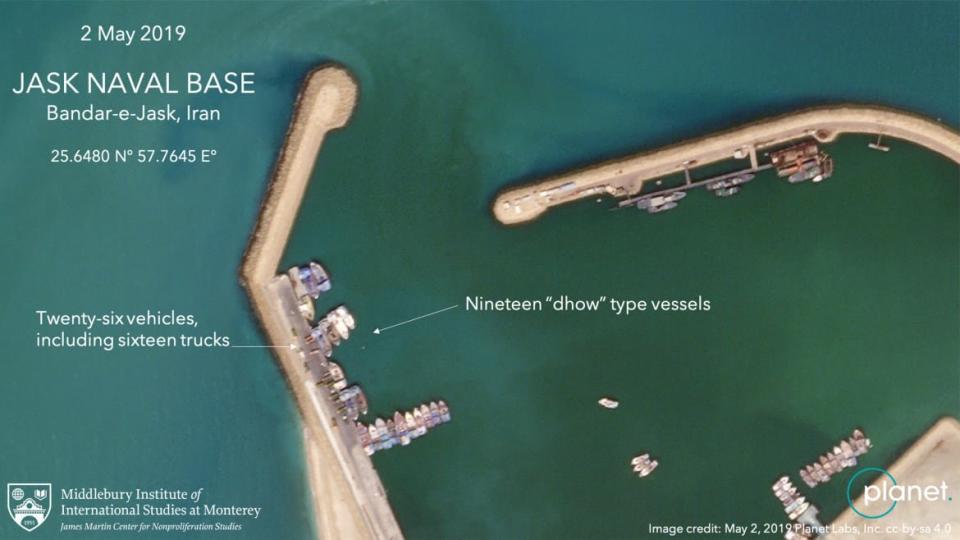Satellite Images Raise Questions About Iran Threat, Experts Say

A piece of evidence in the Trump administration’s case against Iran may be less than it seems.
The Trump administration announced Friday that it is sending 1,500 new troops to the Persian Gulf and authorizing new arms sales to Saudi Arabia and the United Arab Emirates in order to counter a rising Iranian threat in the region. But satellite images provided exclusively to The Daily Beast by the company Planet Labs show that a component of the administration’s description of Iran’s aggressive behavior—an apparent positioning of Iranian missiles onto boats—may not be as clear in commercial imagery as anonymous administration officials claimed it to be in statements to other publications.
The images do show an unusual activity spike at the base where officials told The New York Times they saw Iranian troops loading missiles onto tiny boats known as dhows. A source familiar with the situation told The Daily Beast that U.S. intelligence picked up signs that looked like Iran was developing a capability to quietly launch cruise missiles and “attack oil infrastructure on land” from the boats. Outside experts, however, have doubts about how strong the evidence of missile activity really is. Previously, sources familiar with intelligence about Iranian’s behavior said the administration appeared to be overstating the imminence of the threat. Later, sources told The Daily Beast that U.S. intelligence showed Iran’s new aggressive steps came in direct response to Trump administration moves.
The Times first reported that overhead imagery of missile-loading activity included in a May 3 intelligence assessment rang alarm bells in the Pentagon and that defense officials told lawmakers they had seen missiles loaded onto small boats at the Iranian ports of Chabahar, near the Pakistani border and Bandar-e-Jask.
The satellite imagery, analyzed by experts from the Middlebury Institute of International Studies, shows an unusual amount of vehicle activity on the docks beside small boats at the Bandar-e-Jask base on May 2.

“The trucks are relatively small and any missile would be inside a container. The problem is we don’t know what’s inside the containers, if anything at all,” said Jeffrey Lewis, who analyzed the imagery for The Daily Beast. “It’s interesting but at most it’s a small, niche capability.”
The base, which sits south of the Strait of Hormuz in the Gulf of Oman, is the headquarters of the Islamic Republic of Iran Navy but often hosts troops from the Islamic Revolutionary Guard Corps Navy (IRGCN) during exercises. In the Planet Labs images of the area, 16 trucks and 10 other vehicles parked on the docks are visible carrying containers beside 19 dhow-type boats. Most of those trucks visible at the port have a flatbed approximately seven meters long and one truck appears laden with a container approximately 13-14 meters long.
The dockside May 2 activity at Jask was one—but not the only—source of concern for U.S. administration officials, who described it in detail. But those descriptions appear to be inconsistent with satellite imagery The Daily Beast obtained.
On May 9, the U.S. Maritime Administration warned of an increased risk of Iran and its proxies ”targeting commercial vessels, including oil tankers, or U.S. military vessels” in the region. Shortly thereafter, four tankers were sabotaged in an attack the Pentagon now says was carried out by the IRGC.
The State Department also evacuated non-essential personnel from its embassy in Iraq, citing an increased threat from Iranian-backed militias against U.S. forces and diplomats there. On Sunday, an unknown group launched a rocket which landed near the U.S. embassy compound in Baghdad. Iraqi officials have said that the Iranian-backed Kataib Hezbollah militia launched the rocket but the group has since denied it.
Lewis’ comments about the equivocal satellite imagery echo concerns among Pentagon officials, first reported by the Times, that overhead imagery of Iranian missile loading activity wasn’t sufficient evidence to convince the public and skeptical allies of a missile threat that they claim is clearer in other, more sensitive intelligence collection. The Trump administration reportedly declassified but chose not to publish a satellite photo of a missile-laden dhow.
Intelligence officials have offered conflicting accounts of what kinds of missiles Iran may have loaded onto the boats, further muddying the waters about the intelligence. Sources told CNN and the AP that they had seen signs of short range ballistic missiles being loaded onto boats, ready to fire. The source familiar with the situation, however, told The Daily Beast there was no indication that this was the case. And outside experts say that Iran hasn’t previously demonstrated the ability to launch ballistic missiles from boats.
“We haven't really seen any ship launches of ballistic missiles yet. Launching ballistic missiles from ships is not an easy task so you really would need to do testing,” Fabian Hinz, a researcher who studies Iranian missile development, told The Daily Beast. Hinz said Iranian academic research shows an Iranian university paper published in 2000 did discuss the prospect of loading ballistic missiles onto boats but cautions against reading too much into the research. “You don’t know whether they are part of a large government development program or just two grad students having fun.”
Unlike ballistic missiles, cruise missiles fly parallel to the ground or sea. Cruise missiles disguised in fishing boats would be more consistent with the IRGCN’s traditional tactics and equipment. The Revolutionary Guards have a small fleet of speed boats equipped to carry shorter range anti-ship cruise missiles which regularly patrol the Gulf.
The difference between types of missile activity is important, experts say.
“It’s imperative that Washington understand what sort of missiles Iran was recently accused of moving. The most likely candidates are anti-ship cruise, anti-ship ballistic, or short-range ballistic missiles,” says Behnam Ben Taleblu, a fellow at the Foundation for the Defense of Democracies. “The dispersal and shipment of any of these systems would go a long way towards understanding Iranian patterns of escalation and responses to pressure.”
Lewis, however, is skeptical that the evidence demonstrates a threat proportional to the Trump administration’s reaction. “I can't imagine using an image like this to explain to some mother why her son or daughter had to die invading Iran,” he said.
Get our top stories in your inbox every day. Sign up now!
Daily Beast Membership: Beast Inside goes deeper on the stories that matter to you. Learn more.

